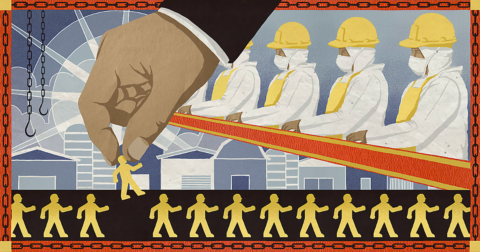News
Our Favorites Stories of 2025
Food•5 min read
News
The precedent in prisons exists.


Words by Grace Hussain
Ten police cars, windows tinted black, line Krome Ave in Miami, Florida. About half of them are unmarked, with plain clothes officers taking pictures and recording the protestors across the four-lane street. The group of protestors are organizing against the detention center tucked back into the trees. Several hundred strong, the group is united by anger surrounding the inhumane treatment afforded their community members, several of whom have been abducted by Immigration and Customs Enforcement (ICE) as detainment efforts continue to rise.
According to the agency’s records, immigrant detention has steadily increased since even before the Trump Administration took office again in January. In 2024, an average of 37,722 people were being held at detention centers at any given time, a significant increase over the 19,254 average in 2021, the year President Biden took office. Last month, the number of detainees rose even further, to 47,304.
As detention numbers creep upward, some advocates are worried that detainees could be compelled to work to fill gaps in the workforce of some of the most dangerous jobs in the country, including on factory farms and in slaughterhouses. “Over the last decade or so, ICE has been contracting with private organizations to run their detention centers, very much like prisons have been doing. Those private companies have been making detainees work for $1 a day,” Amal Bouhabib, senior staff attorney with the legal advocacy organization FarmSTAND, tells Sentient.
To be clear, there is no evidence this is happening right now in ICE detention centers, but advocates are worried this could change.
Josh Sbicca, who runs the Prison Agriculture Lab out of Colorado State University’s sociology department, shares Bouhabib’s concern. He sees a potential future where “the people who are targeted by this program of mass deportation end up in carceral facilities, only to be forced to work back on some of the farms that they were originally working on” — though he’s quick to add that he believes laws would need to change in order for that to happen.
According to Bouhabib, it’s possible, based on current ICE regulations such as the Voluntary Work Program, that centers could enter into labor contracts on behalf of detainees. “It seems like those private detention centers, the labor that they’ve been subjecting the workers to has been mostly on the detention site,” she says. They’re doing things “like cleaning and food and stuff like that, but I didn’t see anything that would stop them from contracting detainees outside of the detention center.”
The U.S. agriculture industry has a long history of relying on detained people for labor — usually people who have been incarcerated and leased out by prisons. The difference is that prison labor has long been justified as part of prisoners’ punishment for committing a crime, one that often lacks any real compensation. The people detained in ICE centers are often not currently accused of crimes, and are now being compelled to work, a fact that has fueled legal challenges to forced labor.
Immigrants are central to the animal agriculture business. In their 2015 report on the economic impact of immigrant labor on U.S. dairy, the National Milk Producers Federation noted that over half of labor in the dairy industry is performed by immigrants, and dairy farms that rely on immigrant workers produce 79 percent of the country’s milk.
The meat industry offers a similar story. In their 2023 shareholder report, Tyson — one of the “Big Four” companies controlling the beef market — noted that policy changes on immigration could lead to labor shortages in their supply chain. According to an analysis carried out by the Economic Policy Institute, over 70 percent of animal slaughtering and processing workers are non-citizens, including undocumented people, temporary residents and permanent residents.
Part of the reason that animal agriculture, and agriculture more broadly, relies so heavily on immigrant labor is because of the nature of the work, says Sbicca. “Many frontline agricultural workers are just not paid a lot of money, and they’re working under really difficult and dangerous conditions,” he says. In slaughter and processing, for example, employees are subjected to injuries from the repetitive nature of the work, the sharp tools with which they work, high line speeds and the animals themselves. By the time they reach the slaughterhouse, animals are usually stressed and terrified due to the long journey they’ve already endured, increasing the danger they pose to workers.
It can also be hard to hire for work in agriculture because many jobs have been racialized, says Sbicca. “It’s understood that farm work is the work of immigrants of color, primarily from Mexico and Central America,” he explains. Because many people buy into that stereotype wholeheartedly, they wouldn’t consider taking on agricultural work because, in their minds, it would threaten their whiteness, he says. That, combined with the poor working conditions and mental and physical burden of meatpacking and slaughterhouse work, makes employment in the industry unappealing for many citizen workers.
Some employers are also eager to seize the opportunity to take advantage of immigrant workers, Bouhabib points out. She tells the story of a group of refugees with whom she worked. They were working in the industry in Nebraska, and had been in the United States long enough to become citizens. When they sought her help, “they were being pushed out in favor of new immigrants, because new immigrants are more exploitable,” says Bouhabib.
One prevalent example of immigrant exploitation is child labor. Young immigrant children are often illegally employed to work in dangerous agricultural jobs for minimal pay, and can end up seriously or fatally harmed. “What we have found in the last five years is this uptick of serious child labor exploitation in industries such as manufacturing, meatpacking plants [and] poultry processing plants where we have very young kids that are cleaning very dangerous equipment on the kill floor at 2:00 in the morning,” a spokesperson for the Department of Labor told Sentient last year.
In light of the increased ICE operations and efforts to allow more localized police forces to detain immigrants, it’s likely to get easier to exploit immigrants at their places of work. “I think what this Administration and Big Ag wants to create is this environment of fear,” says Bouhabib. “Whether or not they get deported or detained, they’re not going to speak up for their rights.”
Back at the detention center on Krome Ave, the crowd breaks into boos; a bus sporting windows reinforced with metal and driven by ICE officers in bulletproof vests rolls into the center. Over the next fifteen minutes, several large, unmarked white vans follow in its tracks.
Unlike prison labor, which is governed under the constitution, the rules pertaining to immigrants who have been detained by ICE are set out by the Agency’s regulations. Their “Voluntary Work Program” allows detention centers to offer work, including “labor intensive work” to detainees. The goals of the program are framed as being primarily altruistic — offering opportunities for detainees to make money, cutting down on “disciplinary incidents” and improving “essential operations and services.”
What the regulations fail to mention is that the work program cuts center operating costs significantly. While federal minimum wage has stagnated at $7.25 an hour, 34 of the country’s states, territories and districts have higher expectations; the District of Columbia guarantees $17.50 an hour, with Washington state following closely behind at $16.66. Those rates are well above the $1 a day, or $0.13 an hour, that centers are required to pay detainees to do the same work. The work program saves centers at least $40 million in labor costs annually.
It’s an ironic move on the part of the detention centers, given one of the most prominent stereotypes of undocumented immigrants is that they’re taking jobs away from citizens. The private businesses that overwhelmingly run the centers are choosing to take advantage of their captive populations in order to avoid paying higher wages to citizens. An ongoing lawsuit brought by Washington state against GEO Group, one of the two companies running most private detention centers, will likely determine whether the $1/day standard supersedes state minimum wage requirements. Sentient reached out to GEO Group for comment and was directed to contact ICE directly. We reached out to ICE but have so far received no reply.
The program has also been accused of being less than voluntary, as numerous firsthand accounts of being coerced or forced to work against their will have emerged from people detained inside ICE facilities. Allegations against the agency range from officers threatening retaliation if detainees refuse to work, to detainees receiving insufficient amounts of food and having to work to make money to buy additional food at the commissary.
Since Trump has returned to the White House, immigration attorneys and advocates have continued to raise alarms about actions by ICE, including a lack of transparency from the agency. One practical effect of this is that advocates have been left mostly in the dark about what might happen next, including, but not limited to, changes to the way detainees are put to work.